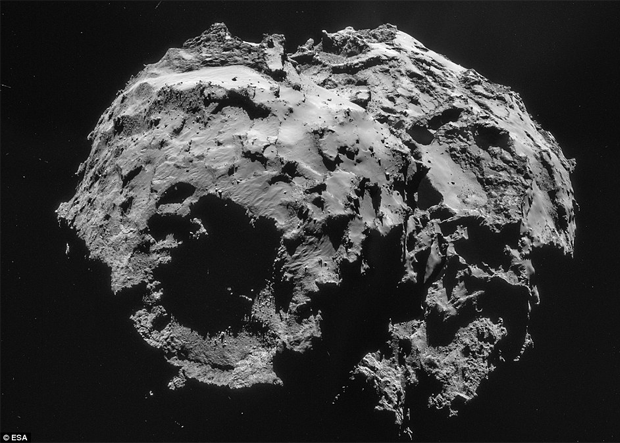|
If this cliff was on Earth it'd be among the tallest
in the world - but it's on a comet just two and a half miles wide. The
towering, jagged edifice, half a mile high with 65ft boulders at its
foot, was revealed by an amateur astronomer who studied an image beamed
back by the Rosetta probe as it orbits comet 67P/Churyumov–Gerasimenko.
From his home in Kendal in the Lake District, Stuart Atkinson's creation
has been picked by Nasa as its astronomy picture of the day - leading
him to declare with delight: 'Christmas came early for me today!'.
|
|
 |
|
The original image was one of many released from the £1.1billion Rosetta
probe, which has been orbiting comet 67P since it caught up with it in
August following a ten-year, four billion mile chase.
Mr Atkinson relied on notes by the European Space Agency which said the
picture - pieced together from four taken 12 miles from the comet on
December 10 - measured 1.8 by 1.6 miles from end to end.
He tilted and cropped the image so just the cliff remained, pointing
vertically down to what appeared to be the duck-shaped comet's centre.
'As soon as I saw that image I could see one area was just crying out to
be cropped and turned into a landscape view,' he wrote on his blog
Cumbrian Sky. 'Isn't that something?
'I think that is a genuinely stunning view. Just imagine standing there,
at the foot of those cliffs, with those huge boulders scattered all
around you, craning your head back to look up at the wall looming in
front of and above you.'
According to Nasa the boulders at the foot of the ice and rock face,
which are on surprisingly smooth, sandy-looking terrain, could measure
65ft across on their own.
But anyone who jumped off the enormous cliff would be likely to survive
because of the comet's low surface gravity, which is several hundred
thousand times weaker than that on Earth.
|
|

|
|
Rosetta is still orbiting the comet despite scientists losing contact
with its £172million robotic surface lander, Philae, which landed at an
angle with its solar panels partially obscured last month.
That mean the European Space Agency had just 60 hours to gather data
about the comet's make-up before its batteries ran out.
Rosetta itself will remain in orbit around the comet as it hurtles
towards the sun at around 83,900mph, reaching its closest point in
August 2015 before it sweeps around and back out of the solar system.
The project has already been hailed as one of the greatest scientific
achievements of 2014 by the journal Science.
Data from Rosetta recently showed that water on the comet had a
strikingly different composition to that on Earth - suggesting the water
on our world came from an asteroid, not a comet as previously thought.
The half-mile cliff on 67P, about a fifth of the size of the entire
comet, is the same size as the highest sea cliffs on Earth - which tower
half a mile high over the North Pacific Ocean in Molokai, Hawaii.
|
|

|
|
Rosetta is still orbiting the comet despite scientists losing contact
with its £172million robotic surface lander, Philae, which landed at an
angle with its solar panels partially obscured last month.
That mean the European Space Agency had just 60 hours to gather data
about the comet's make-up before its batteries ran out.
Rosetta itself will remain in orbit around the comet as it hurtles
towards the sun at around 83,900mph, reaching its closest point in
August 2015 before it sweeps around and back out of the solar system.
The project has already been hailed as one of the greatest scientific
achievements of 2014 by the journal Science.
Data from Rosetta recently showed that water on the comet had a
strikingly different composition to that on Earth - suggesting the water
on our world came from an asteroid, not a comet as previously thought.
The half-mile cliff on 67P, about a fifth of the size of the entire
comet, is the same size as the highest sea cliffs on Earth - which tower
half a mile high over the North Pacific Ocean in Molokai, Hawaii.
|